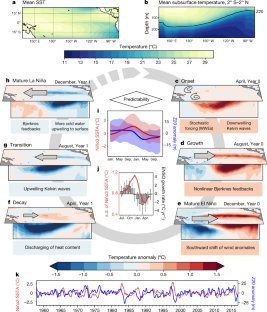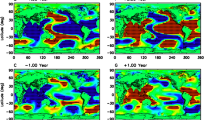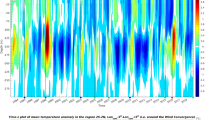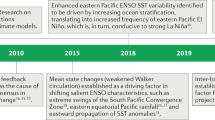Abstract
El Niño events are characterized by surface warming of the tropical Pacific Ocean and weakening of equatorial trade winds that occur every few years. Such conditions are accompanied by changes in atmospheric and oceanic circulation, affecting global climate, marine and terrestrial ecosystems, fisheries and human activities. The alternation of warm El Niño and cold La Niña conditions, referred to as the El Niño–Southern Oscillation (ENSO), represents the strongest year-to-year fluctuation of the global climate system. Here we provide a synopsis of our current understanding of the spatio-temporal complexity of this important climate mode and its influence on the Earth system.
This is a preview of subscription content, access via your institution
Access options
Access Nature and 54 other Nature Portfolio journals
Get Nature+, our best-value online-access subscription
$29.99 / 30 days
cancel any time
Subscribe to this journal
Receive 51 print issues and online access
$199.00 per year
only $3.90 per issue
Buy this article
- Purchase on Springer Link
- Instant access to full article PDF
Prices may be subject to local taxes which are calculated during checkout





Similar content being viewed by others
Change history
20 February 2019
In this Review, the middle initial of author Kim M. Cobb was omitted. The original Review has been corrected online.
References
Carrillo, C. N. Hidrografía oceánica. Bol. Soc. Geogr. Lima 1, 72–110 (1893).
Bjerknes, J. Atmospheric teleconnections from the equatorial Pacific. Mon. Weath. Rev. 97, 163–172 (1969).
McPhaden, M. J., Busalacchi, A. J. & Anderson, D. L. T. A TOGA retrospective. Oceanography 23, 86–103 (2010).
Cai, W. J. et al. More extreme swings of the South Pacific convergence zone due to greenhouse warming. Nature 488, 365–369 (2012).
Capotondi, A. et al. Understanding ENSO diversity. Bull. Am. Meteorol. Soc. 96, 921–938 (2015).
Kug, J. S., Jin, F. F. & An, S. I. Two types of El Niño events: cold tongue El Niño and warm pool El Niño. J. Clim. 22, 1499–1515 (2009). This study demonstrates that the two types of El Niño (CP and EP) have different dynamical structures, including discharge processes and dominant SST feedbacks.
Ashok, K., Behera, S. K., Rao, S. A., Weng, H. Y. & Yamagata, T. El Niño Modoki and its possible teleconnection. J. Geophys. Res. Oceans 112, C11007 (2007).
Takahashi, K., Montecinos, A., Goubanova, K. & Dewitte, B. ENSO regimes: reinterpreting the canonical and Modoki El Niño. Geophys. Res. Lett. 38, L10704 (2011).
Tziperman, E. & Yu, L. S. Quantifying the dependence of westerly wind bursts on the large-scale tropical Pacific SST. J. Clim. 20, 2760–2768 (2007).
Lengaigne, M. et al. Triggering of El Niño by westerly wind events in a coupled general circulation model. Clim. Dyn. 23, 601–620 (2004).
Choi, J., An, S. I. & Yeh, S. W. Decadal amplitude modulation of two types of ENSO and its relationship with the mean state. Clim. Dyn. 38, 2631–2644 (2012).
L’Heureux, M. L. et al. Observing and predicting the 2015/16 El Niño. Bull. Am. Meteorol. Soc. 98, 1363–1382 (2017).
Jin, F. F., Kim, S. T. & Bejarano, L. A coupled-stability index for ENSO. Geophys. Res. Lett. 33, L23708 (2006).
Hoerling, M. P. & Kumar, A. Why do North American climate anomalies differ from one El Niño event to another? Geophys. Res. Lett. 24, 1059–1062 (1997).
Karoly, D. J. & Hoskins, B. J. 3 dimensional propagation of planetary waves. J. Meteorol. Soc. Jpn 60, 109–123 (1982).
Ropelewski, C. F. & Halpert, M. S. Global and regional scale precipitation patterns associated with the El-Niño Southern Oscillation. Mon. Weath. Rev. 115, 1606–1626 (1987).
Larkin, N. K. & Harrison, D. E. On the definition of El Niño and associated seasonal average US weather anomalies. Geophys. Res. Lett. 32, L13705 (2005).
Cobb, K. M. et al. Highly variable El Niño-Southern Oscillation throughout the holocene. Science 339, 67–70 (2013).
McGregor, S., Timmermann, A., England, M. H., Timm, O. E. & Wittenberg, A. T. Inferred changes in El Niño–Southern Oscillation variance over the past six centuries. Clim. Past 9, 2269–2284 (2013). This study uses multi-proxy data to demonstrate that ENSO variance has increased over the past century relative to the previous 500 years.
Cai, W. J. et al. ENSO and greenhouse warming. Nat. Clim. Change 5, 849–859 (2015).
Rasmusson, E. M. & Carpenter, T. H. Variations in tropical sea-surface temperature and surface wind fields associated with the Southern Oscillation El-Niño. Mon. Weath. Rev. 110, 354–384 (1982).
Wang, C. Z. On the ENSO mechanisms. Adv. Atmos. Sci. 18, 674–691 (2001).
Jin, F. F. An equatorial ocean recharge paradigm for ENSO. Part I: conceptual model. J. Atmos. Sci. 54, 811–829 (1997). This paper introduces a heuristic model that explains key features of ENSO dynamics, such as the important role of recharge and discharge processes in ENSO.
Roberts, A., Guckenheimer, J., Widiasih, E., Timmermann, A. & Jones, C. Mixed-mode oscillations of El Niño-Southern Oscillation. J. Atmos. Sci. 73, 1755–1766 (2016).
Levine, A. F. Z. & Jin, F. F. Noise-induced instability in the ENSO recharge oscillator. J. Atmos. Sci. 67, 529–542 (2010).
Rayner, N. A. et al. Global analyses of sea surface temperature, sea ice, and night marine air temperature since the late nineteenth century. J. Geophys. Res. Atmos. 108, 4407 (2003).
Giese, B. S. & Ray, S. El Niño variability in simple ocean data assimilation (SODA), 1871–2008. J. Geophys. Res. Oceans 116, (2011).
Johnson, N. C. How many ENSO flavors can we distinguish? J. Clim. 26, 4816–4827 (2013).
Kug, J. S. & Ham, Y. G. Are there two types of La Niña? Geophys. Res. Lett. 38, L16704 (2011).
Kao, H. Y. & Yu, J. Y. Contrasting eastern-Pacific and central-Pacific types of ENSO. J. Clim. 22, 615–632 (2009).
Lengaigne, M. & Vecchi, G. A. Contrasting the termination of moderate and extreme El Niño events in coupled general circulation models. Clim. Dyn. 35, 299–313 (2010).
An, S.-I., Kug, J.-S., Timmermann, A., Kang, I.-S. & Timm, O. The influence of ENSO on the generation of decadal variability in the North Pacific. J. Clim. 20, 667–680 (2007).
Deser, C., Simpson, I. R., McKinnon, K. A. & Phillips, A. S. The Northern Hemisphere extratropical atmospheric circulation response to ENSO: how well do we know it and how do we evaluate models accordingly? J. Clim. 30, 5059–5082 (2017).
Fedorov, A. V., Hu, S. N., Lengaigne, M. & Guilyardi, E. The impact of westerly wind bursts and ocean initial state on the development, and diversity of El Niño events. Clim. Dyn. 44, 1381–1401 (2015).
Seiki, A. & Takayabu, Y. N. Westerly wind bursts and their relationship with intraseasonal variations and ENSO. Part I: statistics. Mon. Weath. Rev. 135, 3325–3345 (2007).
Jin, F. F., Lin, L., Timmermann, A. & Zhao, J. Ensemble-mean dynamics of the ENSO recharge oscillator under state-dependent stochastic forcing. Geophys. Res. Lett. 34, L03807 (2007).
Vimont, D. J., Battisti, D. S. & Hirst, A. C. The seasonal footprinting mechanism in the CSIRO general circulation models. J. Clim. 16, 2653–2667 (2003). This article presents a coupled air-sea mechanism by which extratropical Pacific climate anomalies can propagate into the tropics.
Hong, L. C. L Ho & Jin, F. F. A Southern Hemisphere booster of super El Niño. Geophys. Res. Lett. 41, 2142–2149 (2014).
Ham, Y. G., Kug, J. S., Park, J. Y. & Jin, F. F. Sea surface temperature in the north tropical Atlantic as a trigger for El Niño/Southern Oscillation events. Nat. Geosci. 6, 112–116 (2013).
Chikamoto, Y. et al. Skilful multi-year predictions of tropical trans-basin climate variability. Nat. Commun. 6, 6869 (2015). This article documents the impact of Atlantic SSTAs on the generation of CP El Niño events.
Yu, J. Y. & Kim, S. T. Relationships between extratropical sea level pressure variations and the central Pacific and eastern Pacific types of ENSO. J. Clim. 24, 708–720 (2011).
Lee, T. & McPhaden, M. J. Increasing intensity of El Niño in the central-equatorial Pacific. Geophys. Res. Lett. 37, L14603 (2010).
Wittenberg, A. T., Rosati, A., Delworth, T. L., Vecchi, G. A. & Zeng, F. R. ENSO modulation: is it decadally predictable? J. Clim. 27, 2667–2681 (2014).
Yeh, S. W. et al. El Niño in a changing climate. Nature 461, 511–514 (2009); erratum 462, 674 (2009).
Capotondi, A. & Sardeshmukh, P. D. Optimal precursors of different types of ENSO events. Geophys. Res. Lett. 42, 9952–9960 (2015).
Xie, R. & Jin, F.-F. Two leading ENSO modes and El Niño Types in the Zebiak–Cane Model. J. Clim. (2018). This study provides theoretical evidence for two coupled modes that resemble EP and CP El Niño events with different timescales and background-state sensitivities.
Ham, Y. G. & Kug, J. S. How well do current climate models simulate two types of El Niño? Clim. Dyn. 39, 383–398 (2012). This work shows that current climate models tend to underestimate the diversity of El Niño owing to dry and cold biases in the equatorial central Pacific.
Bellenger, H., Guilyardi, E., Leloup, J., Lengaigne, M. & Vialard, J. ENSO representation in climate models: from CMIP3 to CMIP5. Clim. Dyn. 42, 1999–2018 (2014).
Bayr, T. et al. Mean-state dependence of ENSO atmospheric feedbacks in climate models. Clim. Dyn. 50, 3171–3194 (2017).
Li, T. Phase transition of the El Niño Southern Oscillation: a stationary SST mode. J. Atmos. Sci. 54, 2872–2887 (1997). This study applied seasonally varying instability to model coupled ENSO dynamics.
Zhang, W. J. et al. Unraveling El Niño’s impact on the East Asian monsoon and Yangtze River summer flooding. Geophys. Res. Lett. 43, 11375–11382 (2016).
Trenberth, K. E. et al. Progress during TOGA in understanding and modeling global teleconnections associated with tropical sea surface temperatures. J. Geophys. Res. Oceans 103, 14291–14324 (1998).
Risbey, J. S., Pook, M. J., McIntosh, P. C., Wheeler, M. C. & Hendon, H. H. On the remote drivers of rainfall variability in Australia. Mon. Weath. Rev. 137, 3233–3253 (2009).
McPhaden, M. J. Genesis and evolution of the 1997–98 El Niño. Science 283, 950–954 (1999).
Vecchi, G. A. & Harrison, D. E. Tropical Pacific sea surface temperature anomalies, El Niño, and equatorial westerly wind events. J. Clim. 13, 1814–1830 (2000).
Wengel, C., Latif, M., Park, W., Harlass, J. & Bayr, T. Seasonal ENSO phase locking in the Kiel Climate Model: the importance of the equatorial cold sea surface temperature bias. Clim. Dyn. 50, 901–919 (2017).
Zebiak, S. E. & Cane, M. A. A model El-Niño Southern Oscillation. Mon. Weath. Rev. 115, 2262–2278 (1987).
Tziperman, E., Zebiak, S. E. & Cane, M. A. Mechanisms of seasonal–ENSO interaction. J. Atmos. Sci. 54, 61–71 (1997).
Galanti, E. et al. The equatorial thermocline outcropping—a seasonal control on the tropical Pacific Ocean–atmosphere instability strength. J. Clim. 15, 2721–2739 (2002).
Dommenget, D. & Yu, Y. S. The seasonally changing cloud feedbacks contribution to the ENSO seasonal phase-locking. Clim. Dyn. 47, 3661–3672 (2016).
Harrison, D. E. & Vecchi, G. A. On the termination of El Niño. Geophys. Res. Lett. 26, 1593–1596 (1999).
Lengaigne, M., Boulanger, J. P., Menkes, C. & Spencer, H. Influence of the seasonal cycle on the termination of El Niño events in a coupled general circulation model. J. Clim. 19, 1850–1868 (2006).
McGregor, S., Timmermann, A., Schneider, N., Stuecker, M. F. & England, M. H. The effect of the south Pacific convergence zone on the termination of El Niño events and the meridional asymmetry of ENSO. J. Clim. 25, 5566–5586 (2012). This work demonstrates that the southward wind shift that leads to the rapid decay of El Niño events is related to the seasonal formation of the South Pacific Convergence Zone.
Stuecker, M. F., Timmermann, A., Jin, F. F., McGregor, S. & Ren, H. L. A combination mode of the annual cycle and the El Niño/Southern Oscillation. Nat. Geosci. 6, 540–544 (2013).
Stuecker, M. F., Jin, F. F., Timmermann, A. & McGregor, S. Combination mode dynamics of the anomalous northwest Pacific anticyclone. J. Clim. 28, 1093–1111 (2015).
Meinen, C. S. & McPhaden, M. J. Observations of warm water volume changes in the equatorial Pacific and their relationship to El Niño and La Niña. J. Clim. 13, 3551–3559 (2000).
Barnston, A., Tippett, M. K., Ranganathan, M. & L’Heureux, M. Deterministic skill of ENSO predictions from the North American Multimodel Ensemble. Clim. Dyn. https://doi.org/10.1007/s00382-017-3603-3 (2017); erratum https://doi.org/10.1007/s00382-017-3814-7 (2017)
Ramesh, N. & Murtugudde, R. All flavours of El Niño have similar early subsurface origins. Nat. Clim. Change 3, 42–46 (2013).
Ballester, J., Bordoni, S., Petrova, D. & Rodo, X. Heat advection processes leading to El Niño events as depicted by an ensemble of ocean assimilation products. J. Geophys. Res. Oceans 121, 3710–3729 (2016).
Izumo, T. et al. Influence of the state of the Indian Ocean Dipole on the following year’s El Niño. Nat. Geosci. 3, 168–172 (2010).
Ham, Y. G., Kug, J. S. & Park, J. Y. Two distinct roles of Atlantic SSTs in ENSO variability: North Tropical Atlantic SST and Atlantic Niño. Geophys. Res. Lett. 40, 4012–4017 (2013).
Takahashi, K. & Dewitte, B. Strong and moderate nonlinear El Niño regimes. Clim. Dyn. 46, 1627–1645 (2016).
Barnston, A. G., Tippett, M. K., L’Heureux, M. L., Li, S. H. & DeWitt, D. G. Skill of real-time seasonal ENSO model predictions during 2002–11: is our capability increasing? Bull. Am. Meteorol. Soc. 93, 631–651 (2012).
Newman, M. & Sardeshmukh, P. D. Are we near the predictability limit of tropical Indo-Pacific sea surface temperatures? Geophys. Res. Lett. 44, 8520–8529 (2017).
Petrova, D., Koopman, S. J., Ballester, J. & Rodo, X. Improving the long-lead predictability of El Niño using a novel forecasting scheme based on a dynamic components model. Clim. Dyn. 48, 1249–1276 (2017).
Kessler, W. S. Is ENSO a cycle or a series of events? Geophys. Res. Lett. 29, 2125 (2002). This study challenges the notion of ENSO as a cycle and highlights the fact that the ENSO system can lose its dynamical memory during long La Niña events.
Barnston, A. G. & Tippett, M. K. Do statistical pattern corrections improve seasonal climate predictions in the North American Multimodel Ensemble models? J. Clim. 30, 8335–8355 (2017).
DiNezio, P. N., Deser, C., Okumura, Y. & Karspeck, A. Predictability of 2-year La Niña events in a coupled general circulation model. Clim. Dyn. 49, 4237–4261 (2017).
McPhaden, M. J. A. 21st century shift in the relationship between ENSO SST and warm water volume anomalies. Geophys. Res. Lett. 39, L09706 (2012).
Jeong, H. I. et al. Assessment of the APCC coupled MME suite in predicting the distinctive climate impacts of two flavors of ENSO during boreal winter. Clim. Dyn. 39, 475–493 (2012).
Larson, S. & Kirtman, B. The Pacific Meridional Mode as a trigger for ENSO in a high-resolution coupled model. Geophys. Res. Lett. 40, 3189–3194 (2013).
Zhang, H. H., Clement, A. & Di Nezio, P. The south Pacific meridional mode: a mechanism for ENSO-like variability. J. Clim. 27, 769–783 (2014).
An, S. I. Interannual variations of the Tropical Ocean instability wave and ENSO. J. Clim. 21, 3680–3686 (2008).
Larson, S. M. & Kirtman, B. P. Linking preconditioning to extreme ENSO events and reduced ensemble spread. Clim. Dyn. https://doi.org/10.1007/s00382-017-3791-x (2017).
Chen, N. & Majda, A. J. Simple dynamical models capturing the key features of the Central Pacific El Niño. Proc. Natl Acad. Sci. USA 113, 11732–11737 (2016).
Hao, Z., Neelin, J. D. & Jin, F. F. Nonlinear tropical air-sea interaction in the fast-wave limit. J. Clim. 6, 1523–1544 (1993).
Schneider, N. The response of tropical climate to the equatorial emergence of spiciness anomalies. J. Clim. 17, 1083–1095 (2004).
McGregor, S., Sen Gupta, A., Holbrook, N. J. & Power, S. B. The modulation of ENSO variability in CCSM3 by extratropical Rossby waves. J. Clim. 22, 5839–5853 (2009).
Xue, Y. et al. A real-time ocean reanalyses intercomparison project in the context of tropical pacific observing system and ENSO monitoring. Clim. Dyn. 49, 3647–3672 (2017).
Widlansky, M. J. et al. Changes in South Pacific rainfall bands in a warming climate. Nat. Clim. Change 3, 417–423 (2013).
Kirtman, B. P., Straus, D. M., Min, D. H., Schneider, E. K. & Siqueira, L. Toward linking weather and climate in the interactive ensemble NCAR climate model. Geophys. Res. Lett. 36, (2009).
Vecchi, G. A. et al. On the seasonal forecasting of regional tropical cyclone activity. J. Clim. 27, 7994–8016 (2014).
Cook, E. R., Seager, R., Cane, M. A. & Stahle, D. W. North American drought: reconstructions, causes, and consequences. Earth Sci. Rev. 81, 93–134 (2007).
Nicholson, S. E. & Selato, J. C. The influence of La Niña on African rainfall. Int. J. Climatol. 20, 1761–1776 (2000).
McPhaden, M. J., Zebiak, S. E. & Glantz, M. H. ENSO as an integrating concept in Earth science. Science 314, 1740–1745 (2006).
Balmaseda, M. A., Mogensen, K. & Weaver, A. T. Evaluation of the ECMWF ocean reanalysis system ORAS4. Q. J. R. Meteorol. Soc. 139, 1132–1161 (2013).
Huang, B. Y. et al. Extended reconstructed sea surface temperature, version 5 (ERSSTv5): upgrades, validations, and intercomparisons. J. Clim. 30, 8179–8205 (2017).
Penny, S. G., Behringer, D. W., Carton, J. A. & Kalnay, E. A hybrid global ocean data assimilation system at NCEP. Mon. Weath. Rev. 143, 4660–4677 (2015).
Puy, M., Vialard, J., Lengaigne, M. & Guilyardi, E. Modulation of equatorial Pacific westerly/easterly wind events by the Madden–Julian oscillation and convectively-coupled Rossby waves. Clim. Dyn. 46, 2155–2178 (2016).
Adler, R. F. et al. The version-2 global precipitation climatology project (GPCP) monthly precipitation analysis (1979–present). J. Hydrometeorol. 4, 1147–1167 (2003).
Acknowledgements
A.T., K.S., K.-S.Y. and E.Z. were supported by the Institute for Basic Science (project code IBS-R028-D1). B.D. was funded by Fondecyt (grant 1151185). S.-I.A. was supported by the Basic Science Research Program through the National Research Foundation of Korea (NRF-2017R1A2A2A05069383). J.-S.K. was supported by the National Research Foundation of Korea (NRF-2017R1A2B3011511). F.-F.J.’s contribution was sponsored through the US NSF Grant AGS-1406601 and the US Department of Energy Grant DE-SC0005110. T.B. receives funding from SFB 754, project ‘Climate–Biochemistry Interactions in the tropical Ocean’. M.J.M. is supported by the US National Oceanic and Atmospheric Administration (NOAA). H.-L.R. is supported by the China Meteorological Special Research Project (grant number GYHY201506013). S.I. was supported by the UK–China Research & Innovation Partnership Fund through the Met Office Climate Science for Service Partnership (CSSP) China as part of the Newton Fund. M.F.S. acknowledges support from the NOAA Climate and Global Change Postdoctoral Fellowship Program, administered by UCAR’s Cooperative Programs for the Advancement of Earth System Sciences (CPAESS). H.R. was partly funded by the National Environmental Science Program, Australia. This is PMEL contribution number 4723. The authors thank the TAO Project Office of NOAA/PMEL for providing the TAO/TRITON 20 °C isotherm depth anomaly data shown in Fig. 5.
Reviewer information
Nature thanks M. L'Heureux, X. Rodo and A. Tudhope for their contribution to the peer review of this work.
Author information
Authors and Affiliations
Contributions
The manuscript was written as a group effort during the ‘El Niño Complexity workshop’, held at Pusan National University from 16 to 20 October 2017. All authors contributed to the manuscript preparation and the discussions that led to the final figure selection. A.T., J.-S.K., S.-I.A. and F.-F.J. designed the study and served as coordinating lead authors for the sections ‘ENSO predictability’, ‘Space–time complexity of ENSO’, ‘A conceptual view of ENSO dynamics’ and ‘A unifying framework’, respectively. A.T. oversaw the writing of each section, preparation of figures and selection of references. W.C., A.C. K.M.C., M.L., M.J.M, M.F.S and A.T.W. served as coordinating lead authors for various sections.
Corresponding author
Ethics declarations
Competing interests
The authors declare no competing interests.
Additional information
Publisher’s note: Springer Nature remains neutral with regard to jurisdictional claims in published maps and institutional affiliations.
Rights and permissions
About this article
Cite this article
Timmermann, A., An, SI., Kug, JS. et al. El Niño–Southern Oscillation complexity. Nature 559, 535–545 (2018). https://doi.org/10.1038/s41586-018-0252-6
Received:
Accepted:
Published:
Issue Date:
DOI: https://doi.org/10.1038/s41586-018-0252-6
This article is cited by
-
Seasonal forecasts of the world’s coastal waterline: what to expect from the coming El Niño?
npj Climate and Atmospheric Science (2024)
-
Global land drought hubs confounded by teleconnection hotspots in equatorial oceans
npj Climate and Atmospheric Science (2024)
-
A distinct and reproducible teleconnection pattern over North America during extreme El Niño events
Scientific Reports (2024)
-
Serious underestimation of reduced carbon uptake due to vegetation compound droughts
npj Climate and Atmospheric Science (2024)
-
Augmented human thermal discomfort in urban centers of the Arabian Peninsula
Scientific Reports (2024)
Comments
By submitting a comment you agree to abide by our Terms and Community Guidelines. If you find something abusive or that does not comply with our terms or guidelines please flag it as inappropriate.



